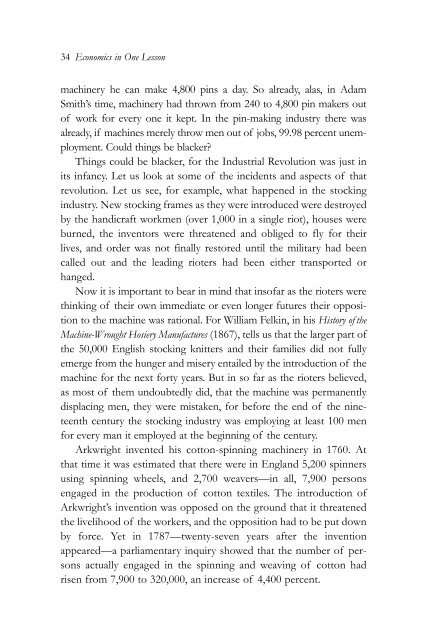1gDdM7w
1gDdM7w
1gDdM7w
- No tags were found...
You also want an ePaper? Increase the reach of your titles
YUMPU automatically turns print PDFs into web optimized ePapers that Google loves.
34 Economics in One Lessonmachinery he can make 4,800 pins a day. So already, alas, in AdamSmith’s time, machinery had thrown from 240 to 4,800 pin makers outof work for every one it kept. In the pin-making industry there wasalready, if machines merely throw men out of jobs, 99.98 percent unemployment.Could things be blacker?Things could be blacker, for the Industrial Revolution was just inits infancy. Let us look at some of the incidents and aspects of thatrevolution. Let us see, for example, what happened in the stockingindustry. New stocking frames as they were introduced were destroyedby the handicraft workmen (over 1,000 in a single riot), houses wereburned, the inventors were threatened and obliged to fly for theirlives, and order was not finally restored until the military had beencalled out and the leading rioters had been either transported orhanged.Now it is important to bear in mind that insofar as the rioters werethinking of their own immediate or even longer futures their oppositionto the machine was rational. For William Felkin, in his History of theMachine-Wrought Hosiery Manufactures (1867), tells us that the larger part ofthe 50,000 English stocking knitters and their families did not fullyemerge from the hunger and misery entailed by the introduction of themachine for the next forty years. But in so far as the rioters believed,as most of them undoubtedly did, that the machine was permanentlydisplacing men, they were mistaken, for before the end of the nineteenthcentury the stocking industry was employing at least 100 menfor every man it employed at the beginning of the century.Arkwright invented his cotton-spinning machinery in 1760. Atthat time it was estimated that there were in England 5,200 spinnersusing spinning wheels, and 2,700 weavers—in all, 7,900 personsengaged in the production of cotton textiles. The introduction ofArkwright’s invention was opposed on the ground that it threatenedthe livelihood of the workers, and the opposition had to be put downby force. Yet in 1787—twenty-seven years after the inventionappeared—a parliamentary inquiry showed that the number of personsactually engaged in the spinning and weaving of cotton hadrisen from 7,900 to 320,000, an increase of 4,400 percent.


